

6/2006
Residential architects see greater attention to property improvements, accessibility


by Kermit Baker, PhD,
Hon. AIA
Chief Economist
The size of new homes in the U.S. has been steadily growing over the past several decades, reflecting the affluence of American homeowners. However, there are recent signs that home sizes have stopped growing, at least for certain home building segments. The first quarter 2006 AIA Home Design Trends survey determined that although 32 percent of residential architecture firms report that home sizes are continuing to increase, 17 percent are seeing them decline. The remainder sees them holding stable. The share reporting that home sizes are declining has risen from a year ago, while the share reporting them as increasing has dropped.
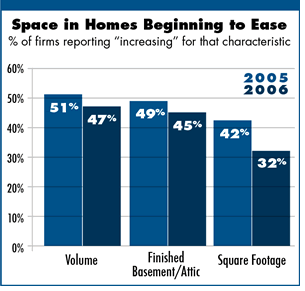 Related to the trends in the size of homes, residential architects also
report ceiling heights and volume of space in homes to be easing somewhat,
as well as a modest slowing in finished basements and attics in homes
in areas where these features are more common.
Related to the trends in the size of homes, residential architects also
report ceiling heights and volume of space in homes to be easing somewhat,
as well as a modest slowing in finished basements and attics in homes
in areas where these features are more common.
Informal spaces more popular
Even as the size of homes appears to be beginning to plateau, the trend
toward informality and accessibility in home design is growing. More
than two-thirds of architects report that the amount of informal space
in the home is increasing, and an equal share sees the trend toward
easier accessibility around the house (for example, wider hallways,
fewer steps) growing in popularity. Both of these trends are more popular
than they were a year ago, according to residential architects.
Also, as the U.S. population ages, single-floor home design is growing in popularity. Almost 40 percent of residential architects see this as a trend becoming more common, up from just less than 30 percent a year ago. An open space floor plan also continues to be a popular option in homes.
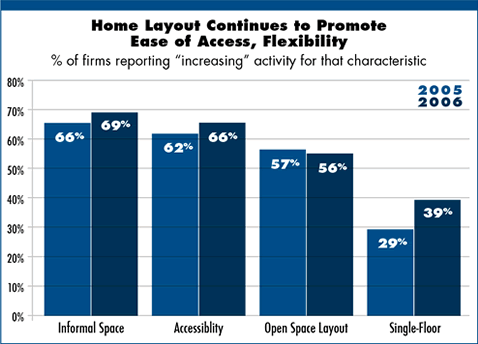
While home sizes look to be stabilizing, households are using their properties more intensely. With more than 40 percent of architects reporting lot sizes shrinking and only 7 percent reporting them to be growing, households are investing more attention on their yards.
Almost two-thirds of architects see an increase in outdoor living space (encompassing such things as decks, patios, and outdoor kitchens), a dramatic increase from just a year ago. Architects also report significant increases in upscale landscaping, outdoor features/amenities (pools, tennis courts, courtyards, and gazebos), and formal lot boundaries (fencing, walls, and bushes).
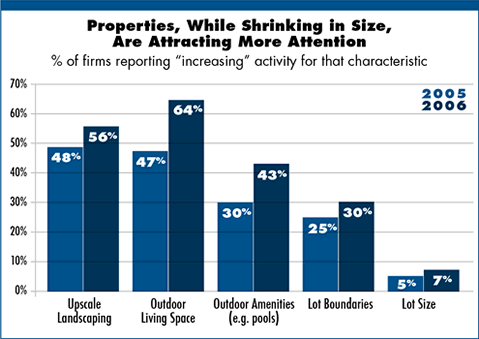
Business trends show market softening
Residential architects have seen business conditions gradually ease over
the past year. There was a slight uptick in project billings at these
firms during the first quarter of 2006, as well as a rebound in inquiries
for new projects. However, in all likelihood, this has to do with residential
activity generally rebounding in late winter and early spring. Both
billings on existing projects and inquiries for new projects are below
year-ago levels.
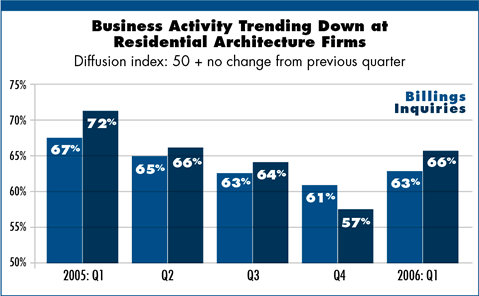
Despite an apparent easing in business conditions at residential architecture firms over the past year, backlogs at these firms—the amount of work currently under contract—remain at favorable levels. They averaged 5.3 months in the first quarter of 2006, up slightly from levels in the first quarter of 2005.
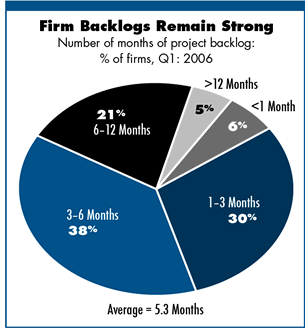 The easing in conditions in the overall residential
market has been very uneven. Certain segments—additions and alterations to existing
homes, as well as kitchen and bath remodeling—are very strong and
have improved since the first quarter of 2005.
The easing in conditions in the overall residential
market has been very uneven. Certain segments—additions and alterations to existing
homes, as well as kitchen and bath remodeling—are very strong and
have improved since the first quarter of 2005.
Townhouses/condos show largest drop
However, most of the construction sectors have weakened. The largest
drops have been in the townhouse/condo segment—which was reported
as very strong a year ago—as well as in the first-time buyer/affordable
segment, which was weak a year ago and has gotten a lot weaker over
the past year, according to architects surveyed. There also has been
a fairly sizeable drop in the health of the move-up home market. The
one construction sector that seems to be faring better than a year
ago is the second home/vacation home market.
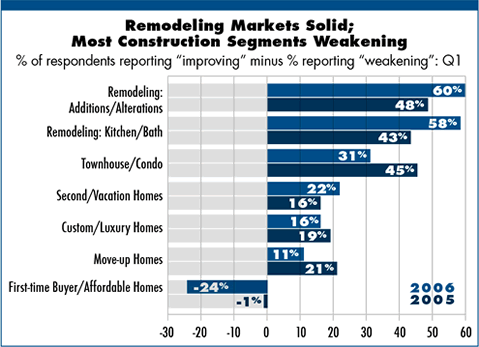
The softening in the housing market encompasses most regions of the country, though there continues to be significant variation in business conditions. The percentage of firms reporting increased billings in the first quarter this year is down about 6 percent nationally from the same quarter in 2005. However, this share has declined at least 10 percent in the Northeast, Midwest, and South. While firms in these three regions have reported fairly significant declines in billings, firms in the West have reported growth. Currently, the strongest business conditions are reported by firms in the West, followed by firms in the South, Northeast, and Midwest.
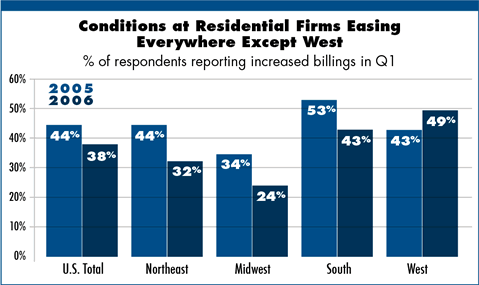
Copyright 2006 The American Institute of Architects.
All rights reserved. Home Page ![]()
![]()
![]()